Listening to the Poor to Alleviate Poverty and Create Lives of Quality and Dignity
- Posted on
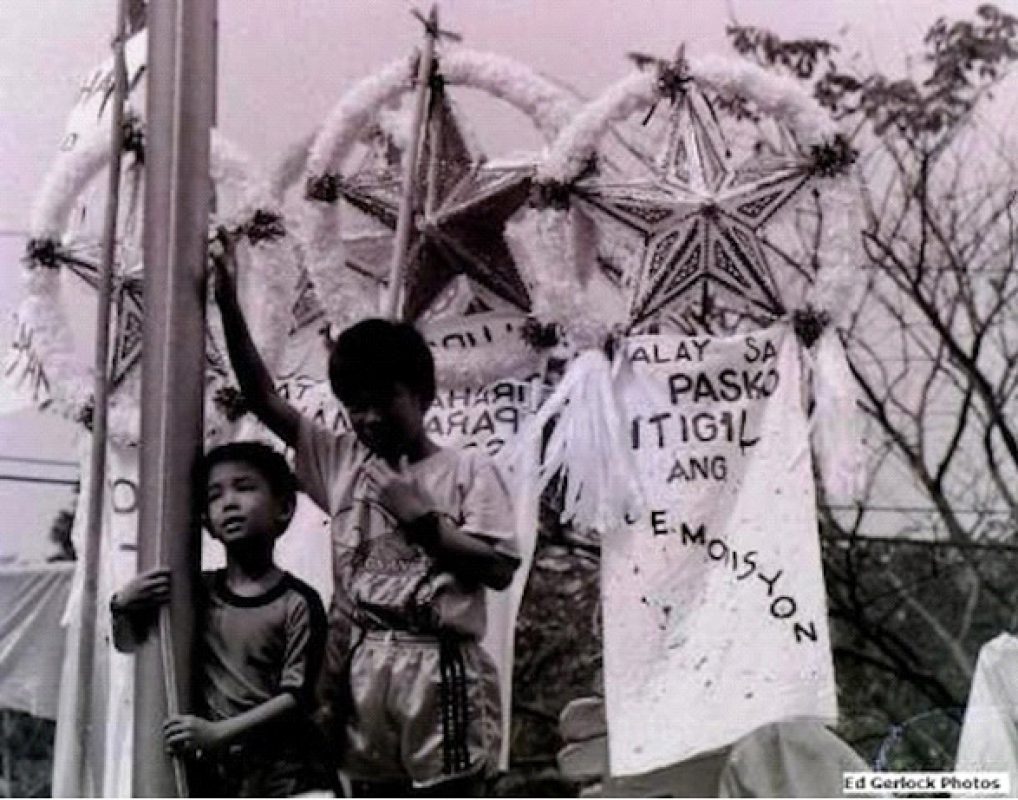
Understanding poverty—its reduction and eventual elimination—calls for going beyond narrow income or consumption measures or strictly economic analyses, to incorporating the wealth of socio-cultural knowledge at hand. The rich sociological, anthropological, and psycho-social literature has for decades been filled with other data that shed light on poverty—its differential causes, expressions, and consequences in societies the world over.
Aside from drawing on wide-ranging analyses from the non-economic social sciences, multidimensional insights on poverty and its alleviation can be derived from the experiences of nongovernmental organizations (NGOs) and other civil society groups active in working with disadvantaged communities—and from poor people themselves.
Consider this statement from “Norma” who lives in the informal settlement of Payatas B in Quezon City, as obtained by researchers of the Institute of Philippine Culture (IPC) of the Ateneo de Manila University (Guevara 2008):
Ang pinakainaasam-asam ko ay magkaroon ng permanenteng tirahan. Sana magkaroon kami ng katiyakan sa paninirahan, at mapasaamin ang lupang ito. Handa akong magbayad hanggang Php 500 kada buwan kung magkakaroon ng CMP [Community Mortgage Program] dito….Bukod sa permanenteng tirahan, sana magkaroon ng permanenteng trabaho ang mga anak ko. Gusto ko ring magkaroon ng malaki-laking puhunan para sa hanapbuhay. Kung mabigyan lang ako ng singkuwenta mil, magtatayo ako ng mas malaki at kumpletong sari-sari store. Iyon lang ang gusto ko—patinda-tinda. Kasi, parang pinakalibangan ko ang makita ang tatlong apo ko, at maalagaan sila.
(My greatest aspiration is to have permanent housing. I hope that we will have security of tenure, and that this land will become ours. I am prepared to pay up to Php 500 a month under the CMP [Community Mortgage Program] if such would be established here…. Aside from permanent housing, I wish for permanent jobs for my children. I would also like to obtain sizeable capital to start my own business. If only I would be given Php 50,000, I would build a larger sari-sari [variety] store than this one I am running, and sell more goods. That’s all I want—to be able to sell from my house. If this were so, I would be able to look after my three grandchildren, who are my greatest source of joy.)
To some from the middle and upper classes, these aspirations for permanent housing, security of land tenure, and sufficient and stable incomes are taken for granted. Not so for Norma, who represents the multitudes of poor people deprived of their basic right to a life of quality and dignity, and who are striving to eke out a living.
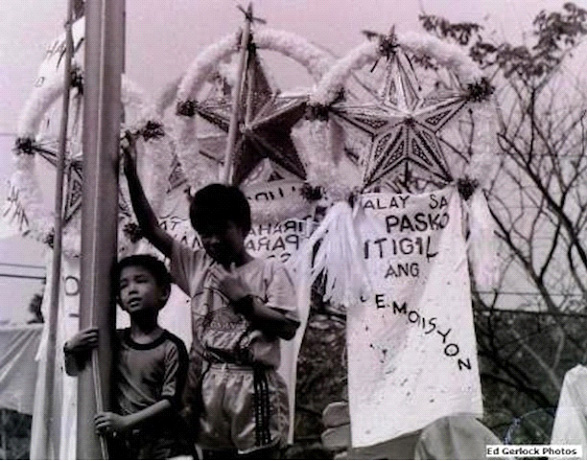
Macro poverty figures
Official statistics show that poverty afflicts nearly one in four Filipinos (25.8%), and one in five Filipino households (20%). According to the most recent statistics released by the Philippine Statistical Authority (based on the 2014 Annual Poverty Indicators Survey [APIS]), the poverty incidence among Filipinos in the first semester of 2014 was estimated at 25.8 percent—marginally higher than the 24.6 percent poverty incidence among Filipinos recorded for the same period in 2013 (PSA 2015) (see Table 1). On the other hand, the poverty incidence among Filipino families according to the 2014 APIS was estimated at 20 percent—a slight increase from the 18.8 percent poverty incidence among Filipino families in the first semester of 2013 (Ibid.) (see Table 1). These families could not meet their basic food and non-food needs because their incomes fell below the official poverty threshold, estimated by the government in the first semester of 2014 to be PhP 8,778 a month for a family of five (Ibid).
Table 1. First Semester Per Capita Thresholds and Incidences: 2013 and 2014
| Statistics | Estimate | Coefficient of Variation | |||
| 1st sem 2013 a/ | 1st sem 2014 b/ | Increase/ Decrease (%) | 1st sem 2013 a/ | 1st sem 2014 b/ | |
| Per Capita Food Threshold (PhP) | 6,712 | 7,350 | 9.5 | ||
| Subsistence Incidence (%) | |||||
| Families | 7.5 | 7.6 | 6.5 | 6.8 | |
| Population | 10.5 | 10.5 | 6.2 | 6.3 | |
| Per Capita Poverty Threshold (PhP) | 9,630 | 10,534 | 9.4 | ||
| Poverty Incidence (%) | |||||
| Families | 18.8 | 20.0 | 4.3 | 4.2 | |
| Population | 24.6 | 25.8 | 4.0 | 3.9 | |
| Food Threshold for a Family of Five (PhP) | 5,593 | 6,125 | 9.5 | ||
| Poverty Threshold for a Family of Five (PhP) | 8,025 | 8,778 | 9.4 |
In comparison, self-rated poverty ratings based on national surveys of the Social Weather Stations (SWS) reveal a much higher poverty incidence among Filipino families. In the Philippines, the SWS, a private survey research institute, has pioneered in the self-rated, bottom-up approach for poverty tracking in which survey respondents give their own interpretation of the word “poverty.” Based on a show card with the word “mahirap” (poor) at one end, “hindi mahirap” (not poor) at the other end, and a line in between—respondents simply point to where they think their own family falls (Mangahas 1999).
According to the September 2015 Social Weather Survey conducted using face-to-face interviews of 1,200 adults nationwide, 50 percent (estimated at 11 million) of families consider themselves mahirap or poor (SWS 2015) (see Chart 1).
Chart 1. Self-rated Poverty: Families who are “Mahirap,” Philippines, Apr 1983 to Sept 2015
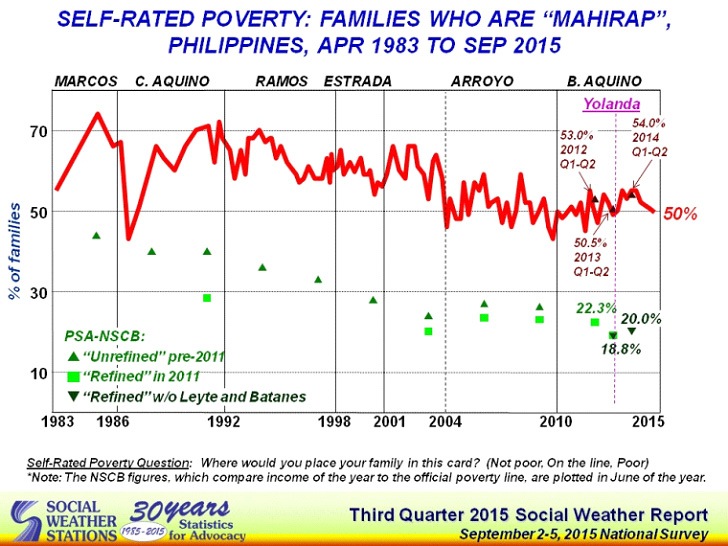
The self-rated poverty incidence of 50 percent is almost twice higher than the official poverty incidence of 25.8 percent, last estimated by the government in the first semester of 2014. Comparing the time-series of self-rated poverty incidence (SWS surveys) with the time series of official poverty incidence (government) reveals that the former always registers roughly twice as many poor. This suggests that official, government-defined poverty really refers to those in much deeper distress, utilizing a criterion like not having enough income to cover food consumption and other, non-food essentials. Twice as many Filipino households saying they consider themselves poor and explaining why, implies that their definition of poverty contains nuances beyond food security and addressing basic non-food needs. The official definition of poverty does not adequately capture these nuances.
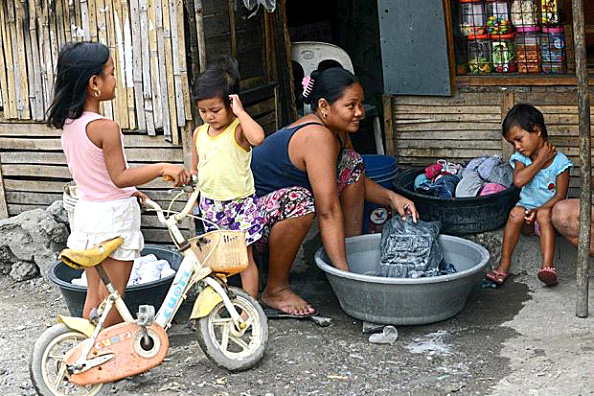
The multidimensionality of poverty and wellbeing
There is a growing consensus among governments and international organizations that poverty dimensions go beyond this traditional view to embody a multitude of nuanced definitions as well as outright causes and effects. Key to understanding it, especially in socio-cultural terms, is the notion of deprivation. Poverty represents a deprivation of essential assets (physical, social, and psychological) to which every human being is entitled (ADB 1999a, 1999b, 2005). It means lacking adequate food, shelter, education, and health. It implies vulnerability to ill health, economic dislocation, and natural disasters. It highlights ill treatment on the part of institutions of the state and society. Poverty is equated with powerlessness to influence key decisions affecting one’s life (World Bank 2000). Nobel laureate Amartya Sen (2000) expresses poverty as living “without fundamental freedoms of actions and choice that the better-off take for granted.”
The companion concept of poverty is wellbeing, which, like poverty, has multiple dimensions. In general, wellbeing is closely identified with good health and disposition, the ability to exercise one’s rights and live a life of personal dignity, the freedom to make economic and political choices, and the opportunity to participate in decisions that affect people’s own lives (CIDA 2000). The absence of these opportunities or the inability of some people to enjoy these conditions is generally equated with poverty, or ill being.
Notions of poverty and wellbeing are culture-specific, calling for assessments within the cultural context of a specific country and taking into consideration the views of the poor themselves. Vulnerable groups remain best placed to define poverty and wellbeing, and to formulate appropriate poverty reduction. Since it is the poor who live and breathe poverty daily, and constitute the most reliable source of information about their experiences and needs, they are in effect “poverty experts” (Narayan, Chambers, Shah, and Petesch 2000). As Narayan (2005: vii) points out, “Poor people are the most important resource in the fight against poverty. They have imagination, guts, knowledge, experience, and deep motivation move out of poverty.”
Social scientists, therefore, need to incorporate into their traditional analytical frameworks the perspectives and experiences of poor people themselves—their conceptions of poverty and wellbeing as well as aspects of their agency which include their efforts—by themselves and linking up with other sectors—to improve their lives and futures.
The heterogeneity of poor people
In a 2007 research of Payatas B in Quezon City, an informal settlement noted for its garbage dumpsite, a household survey of 89 households revealed that the residents regard poverty as a multidimensional phenomenon encompassing economic, social, and psychological elements. Moreover, they can identify particular characteristics for each level of poverty, as follows (Guevara 2007, 2008):
The “very poor” (“mahirap na mahirap”). Who are the “very poor”? According to Payatas research participants, they are the ones who “have nothing to eat” and those “who beg in the streets just to have something to eat.” They have “nowhere to live” and sleep on “the streets, the sidewalk, near canals.” They have “no jobs” because “they were not able to go to school.” Most likely, they “came from the province,” and “knew no one” and had no one to turn to when they migrated to Metro Manila. Moreover, “very poor” households are characterized by their large household size, with seven or eight children, if not more.
The “poor” (“mahirap”). On the other hand, “the poor” do not beg to be able to eat, but “strive and work to feed themselves.” Payatas men and women who were interviewed said that in their community, the “poor” are the scavengers—those who “rummage through garbage in the dumpsite.” Scavengers scrounge for recyclable items like plastic and paper, which they sell to junkshop owners for income. They eat “pagpag”—“left-over food scavenged at the dumpsite, which they wash in hot water then cook again.” If they have some money, they eat rice seasoned with salt, soy sauce, or shrimp paste (bagoong); or rice and cheap fish like sardines; or noodles, which is inexpensive yet filling. Unlike the “very poor,” the “poor” have somewhere in which to live, albeit “small, makeshift houses” built on lots which are not theirs. Hence, they constantly face the threat of demolition. In terms of education, the “poor” finished “only grade one or grade two.” Thus, they cannot find employment and resort to scavenging, from where they “earn little.” Like the “very poor,” the “poor” tend to have large households: “Many of them have eight, seven children,” reported research participants.
The “somewhat poor” (“medyo mahirap”). What characterize the “somewhat poor”? Payatas men and women who participated in the study said that the “somewhat poor” “have jobs,” although “not permanent.” “Counted among them are construction workers” and “contractual employees who are terminated after only five months,” lest they become regular employees entitled to employment benefits. Thus, the lives of the “somewhat poor” are vulnerable: “If they lose their jobs, they have nothing to eat once again,” according to a female interviewee. They eat three times a day but “only ordinary food—vegetables, fish,” although on “rare occasions,” when there’s a “windfall of money,” they manage to buy “some pork and chicken,” As for their housing, the “somewhat poor” are typical “renters in a squatter area.” Compared to the “very poor” and the “poor,” “somewhat poor” households have fewer children: “That’s controlled, around four,” remarked a research participant. The “somewhat poor” also have higher educational attainment. Usually, they are able “to graduate from elementary school” and might have even been “able to reach high school, except that they had to drop out for lack of financial support.”
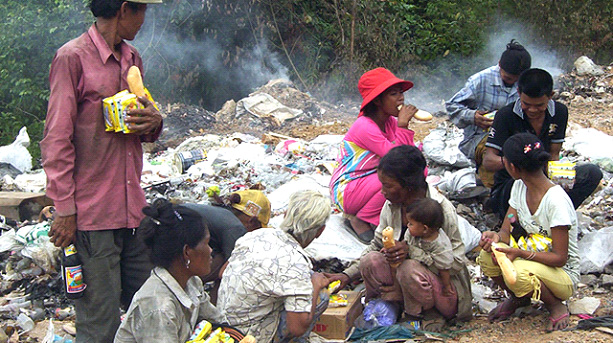
In summary, Payatas men and women recognize that the “poor” or those who are “mahirap” are not all the same. They pointed out that there are indeed some poor men who spend most of their time “drinking and playing cards” (“pag-iinom at pagsusugal ng baraha”), as there are poor women who are into “gossip, gambling too like bingo and cards” (“tsismis, sugal din tulad ng mga bingo at baraha”).
However, the interviewees also stressed that there are many poor people who can be described as “masipag” (“hardworking”), “nagsisikap” (“striving”), and “naghahanapbuhay” (“working for a living”). There are also a number of poor people who are “maka-Diyos” (“God-fearing”), “nagsisimba linggu-linggo” (“attend Mass every week”), and “laging nakaaalala sa Diyos” (“never forget the Lord”).
Thus, even though the “mahirap” or those who are “poor” are not a homogenous group, they share these same characteristics: they lack income, and have limited means to address their needs and to advance in life.
The role of agency: Livelihood and coping strategies of poor households
Poor people’s sense of agency is key to their survival and their escape from poverty. As Carolyn Moser’s (1998) Asset Vulnerability Framework points out, the poor have certain assets (i.e., their labor, human capital, productive assets, household relations, and social capital) which they combine and deploy to eke out a living, if not to improve their lives and escape poverty. Many of the initiatives of the poor have positive consequences for the family in terms of maintaining if not augmenting income. Moreover, these mechanisms demonstrate the remarkable qualities of the poor: their industry, resourcefulness, and resilience. Some mechanisms, however, have deleterious effects on one’s self, family members, other members of the community and society, and the environment. Poor people’s livelihood and coping strategies include the following:
Increasing and diversifying labor. For the poor whose greatest asset is their labor, a major livelihood or income-augmenting strategy is increasing their labor supply, through looking for secondary sources of income or working longer hours. If these efforts are not enough to satisfy basic consumption needs, other members of the household are mobilized to expand the labor supply, including children (who sometimes have to stop their schooling to work) and older members of the family.
Another livelihood strategy is diversification of income sources. For example, upland farmers, including indigenous peoples, whose marginal lands cannot provide enough production for subsistence needs, seek additional income sources by gathering rattan and firewood. Women agricultural workers augment their regular labor on the farm by producing blankets, pottery, brooms, beadwork, baskets, and mats for sale. Fisherfolk derive part of their income from farming, domestication of animals, vegetable-planting, and tending a small store (Callanta 1998).
Urban migration or overseas employment. In areas where local labor markets cannot generate sufficient demand for unskilled labor, households move into the uplands or begin their migration to the city or overseas. Reverse migration also occurs as unemployed urban dwellers return to their homes in rural communities where they can at least plant crops to eat.
Reducing expenditures. The primary coping strategy adopted by poor households is cutting back on expenditures. Here, the major adjustments made are in food consumption. Cheaper food takes the place of more expensive, higher-quality sources of calories. For the bottom-poor, the change in food consumption means a reduction in food intake—from three meals a day to two or even one (Knowles, Pernia, and Racelis 1999). Education, health, and recreation also offer cost-cutting opportunities, as do water and electric consumption, along with deferred purchases of clothing and repairing of houses and equipment.
Selling or renting out assets. Vulnerable groups also cope with the crisis by selling or renting out assets. The rural poor sell their livestock and, if necessary, their land. The urban poor, on the other hand, sell their watches, few items of jewelry and appliances, or offer a room in their house for rent. Those among them who have electricity and water sell these to their poorer neighbors at inflated rates. In some cases, limited by their meager economic assets, poor people commoditize their own bodies. Urban poor residents in Manila have been reported to sell their blood to small blood banks, or even their kidneys in the international trade of body organs.
Borrowing of money and food. Another coping strategy for poor households is borrowing money and food. First, they seek assistance from their family, then their friends, then neighbors and other community members, or occasionally a former employer. They are unlikely to take out formal bank loans or go to government credit institutions, as these entities do not make loans widely and easily available to the poor. If potential lenders in the family or neighborhood do not come through, the poor turn to loan sharks (known in the Philippines as “5-6”), who charge usurious interest rates of 20 percent.
How the poor further tap their support networks is discussed in the next section on social capital.
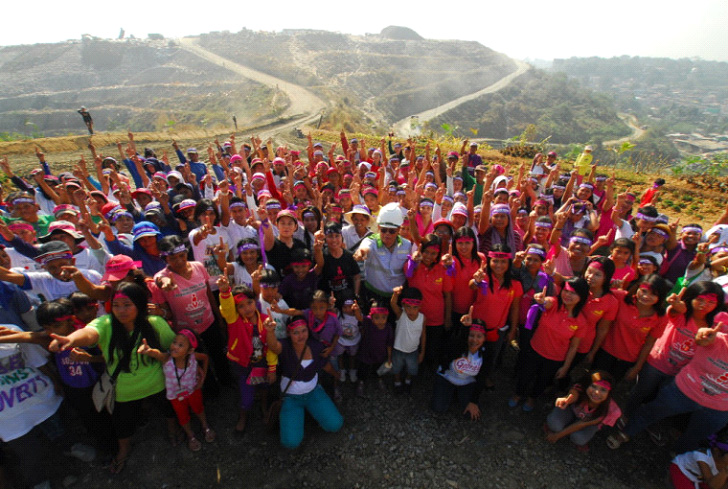
The role of social capital
The ability of the poor to survive depends greatly on their own ingenuity and perseverance. Laudable though sheer grit and determination may be, they also need help in coping with shocks, and thus tap into the social capital built up in the community.
Social capital refers to the norms and social relations embedded in social structures that enable people to coordinate action and achieve desired goals (Narayan 1999). Unlike economic capital, which focuses on access to means of production and consumption, or human capital, which draws on access to education, social capital is relational. It is based on people’s relationships with others that can be harnessed to their advantage (Portes cited in Narayan 1999). Social capital is created when people form social connections and networks based on principles of mutual trust, reciprocity, and norms for action (Racelis 1999). These relationships and connections can be either horizontal or vertical, and embody implicit contracts sustained by cultural norms and values.
Bonding social capital refers to “relations between family members, close friends, and neighbors” (Woolcock [2001]: 10)—people who know each other very well and have strong ties with each another. Bridging social capital, on the other hand, implies looser ties between “more distant friends, associates, and colleagues” (Ibid.) Bonding and bridging social capital involve essentially horizontal relationships “between people who share broadly similar demographic characteristics” (Ibid.)
Social capital, however, also has a vertical relations, as represented by linking social capital. According to Woolcock ([2001]: 11), the “capacity to leverage resources, ideas, and information from formal institutions beyond the community is a key function of linking social capital.” Linking social capital includes ties with civil society organizations (NGOs), government agencies, elected political leaders (mayors, senators), or the private sector (banks).
The ability of the poor to survive adverse conditions if not rise out of poverty depends, for the most part, on their access to bonding, bridging, and social capital.
In the 2007 study of Payatas B conducted by researchers of the Institute of Philippine Culture, research participants narrated how they actively initiated or participated in community efforts to improve their wellbeing. In an interview, “Adelina” expressed great pride in her being a concerned citizen of Payatas B. She has long been active in the neighborhood association Bisig ng Magkakapitbahay (Neighbors Linking Arms), which was was instrumental in bringing electricity, water, and telephones to their place (Guevara 2008):
Noong una kaming lumipat dito noong 1979, bunduk na bundok ito kasi talahiban pa ito noon. Ang mga nakatanim dito ay saging, kamoteng kahoy—iyan ang itinatanim namin dito para mamatay ’yung mga talahib. Wala pang kuryente, at ang tubig, binibili namin. Pagkatapos, nagtatag kami ng asosasyon dito—Bisig ng Magkakapitbahay. ’Yung president namin sa Bisig noon, inaplayan niya ng kuryente itong lugar namin. Nagkakuryente kami…. Noong umalis sa Payatas ang presidente namin… in-endorse niya sa akin ang mga papeles ng Bisig. Kaming taga-Bisig na naiwan ay nagpatuloy pa rin. Inaplayan namin ang lugar namin ng tubig na NAWASA, pagkatapos ay nagkaroon kami ng telepono.
(When we first moved here in 1979, this area seemed so remote from civilization because it was full of weeds. We planted bananas and sweet potatoes to kill the weeds. We had no electricity then, and we had to buy water. And then we formed an association here—the Bisig ng Magkakapitbahay [Neighbors Linking Arms]. Our Bisig president then applied for electricity for our area. We then had electricity…. When our president left Payatas… he endorsed the documents of Bisig to me. We Bisig members who stayed behind continued to improve our place. We applied to NAWASA for water for our area, and after that we got telephones.)
In a 2013 study of the Institute of Philippine Culture conducted in another informal settlement, namely, Baseco in the Port Area, Manila, many of the research participants interviewed showed a strong sense of involvement in and concern for the community: they were members of community organizations, were active in their church, and attended Barangay Assemblies. Particularly impressive was how the people’s organization Kabalikat sa Pagpapaunlad ng Baseco Compound (Linking Arms in Developing Baseco Compound) has led Baseco in many activities: conducting a survey of 72 households in 2001 to ascertain the economic and living conditions of the people; creating a People’s Plan which proposed recommendations for spatial and social organization, towards facilitating onsite housing development in Baseco; and pushing for the proclamation of Baseco by President Gloria Macapagal Arroyo in 2002 (Guevara 2014).
Beyond organizing themselves to address problems in their community, the poor build coalitions which have been influential in the passage of progressive social legislation. In the Philippines, these include: the Congress for a People’s Agrarian Reform (CPAR), a coalition of NGOs and peasant alliances that lobbied in the late 1980s for the passage of the Comprehensive Agrarian Reform Law (CARL) in 1991; the advocacy and pressure of civil society groups—including NGOs and urban poor organizations—that resulted in the passage of the Urban Developing and Housing Act (UDHA) in 1992; and more recently, the strong campaign waged by the Reproductive Health Alliance Network (RHAN)—comprised of health NGOs, women’s organizations, and organized women from poor communities—that contributed to the passage of the Responsible Parenthood and Reproductive Health Act of 2012 (or the RH Law). People’s organizations have also been involved in campaigns against corruption and the advocacy for good governance—and even in the social movement that toppled the Marcos regime in 1986—realizing as they do that transitions out of poverty are enabled by positive democratic functioning.
Recapitulation
Any poverty-reduction program or initiative, including studies on poverty, must include the poor—a most critical partner in efforts to alleviate poverty. Their full engagement in the development process—in collaboration with other sectors such as the government, NGOs, faith-based groups, and the private sector—is imperative. Such a view shifts away from the usual assumptions that the development community has come to take for granted: that development can be created or engineered or brought to the poor among whom it is lacking; that it is something brought to them by others who are presumably more developed; and that it is done on behalf of third parties not by communities/the subjects of intervention (Kaplan 1999).
At the end of the day, external agents are mere facilitators of development, opening up possibilities rather than closing them down. Driven from within, its final gauge would be the poor, the human agents themselves. In conclusion, the whole point of development is to enable people to participate in the governance of their own lives. For this reason, this article underscored the importance of listening to what poor people have to say. People like Norma and Adelina from Payatas B understand their situation more than anyone else does or ever will, and have done a lot to survive, if not to have better lives.
__________________________________________________________________________________
This section draws heavily from Racelis and Guevara 2001 and 2003.
References:
Asian Development Bank (ADB). 1999a (October). Fighting poverty in Asia and the Pacific: The poverty reduction strategy of the Asian Development Bank. Mandaluyong City, Metro Manila, Philippines: Asian Development Bank.
1999b (September). Reducing Poverty: Major Findings and Implications, Manila, Mandaluyong City, Metro Manila, Philippines: Asian Development Bank.
2005. Poverty in the Philippines: Income, assets, and access. Mandaluyong City, Metro Manila, Philippines: Asian Development Bank, January.
Callanta, Ruth S., 1988, Poverty: The Philippine Scenario, Makati, Metro Manila: Bookmark, Inc.
Canadian International Development Agency (CIDA). 2000. Enquiry into poverty reduction in Asia: Who cares for Asia’s poor? Quebec: Canadian International Development Agency.
Guevara, Marita Concepcion Castro. 2007. Moving out of poverty: Poor and once-poor urbanites’ experience of mobility and wellbeing in an urban informal settlement in Metro Manila. Paper presented at the Conference on “Mainstreaming Human Security: The Asian Contribution,” Panel 4 on Urban Security, Chulalongkorn University, 4 October 2007.
2008. Moving in and out of poverty: Understanding social mobility from the perspectives of the still-poor, now-poor, once-poor, and never-poor of Payatas B, Quezon City. PhD dissertation, University of the Philippines Diliman.
2014. Understanding movements in and out of poverty and vulnerability in Baseco, Tondo using John J. Carroll’s SJ’s conceptions of social inequality and social change. Paper presented at the 2014 National Conference of the Philippine Sociological Society (Crises, Resiliency, Community: Sociology in the age of disasters), Festschrift panel in honor of sociologist John J. Carroll, SJ, PhD (1924-2014), Mindanao State University – General Santos City, 18 October.
Kaplan, Allan (The Proteus Initiative). 1999. The development of capacity. [Cape Town, South Africa]: Community Development Resource Association. Originally published as a Development Dossier by the United Nations Non-Governmental Liaison Service. Available from http://institutofonte.org.br/sites/default/files/Kaplan%20A_The%20 Developing%20Of%20Capacity.pdf;
Knowles, James C., Ernesto M. Pernia, and Mary Racelis. 1999. Social consequences of the financial crisis in Asia. ADB Economics and Development Resource Center paper. Manila (November).
Mangahas, Mahar. 1999. Monitoring Philippine poverty by operational social indicators. Paper presented to the World Bank’s Poverty Reduction and Economic Management (PREM) Network, PREM Week 99, 13-14 July 1999, University of Maryland University College, College Park, Maryland.
Moser, Caroline. 1998. Reassessing urban poverty reduction strategies: The asset vulnerability framework. World Development 26 (1): 1-19.
Narayan, Deepa. 1999. Bonds and bridges: Social capital and poverty. Washington, D.C.: The World Bank (August).
ed. 2005. Measuring empowerment: Cross-disciplinary perspectives. Washington, D.C.: The International Bank for Reconstruction and Development/ The World Bank.
Robert Chambers, Meera K. Shah, and Patti Petesch. 2000b. Voices of the poor: Crying out for change. New York: Oxford University for the World Bank.
Philippine Statistical Authority (PSA). 2015. Poverty incidence among Filipinos registered at 25.8%, as of first semester of 2014 – PSA. Available from nscb.gov.ph/poverty/ default.asp
Racelis, Mary. 1999. Cities for twenty-first century people: A regional perspective on urban poverty in Asia. Regional Development Dialogue 20 (1) (Spring): 1-15. United Nations Centre for Regional Development, Nagoya, Japan.
__ and Marita Concepcion Castro Guevara. 2001/2003. Sociocultural factors affecting poverty and poverty reduction in Asia. A report submitted to the Asian Development Bank. Paper delivered at the Conference on Poverty, Growth and the Role of Institutions, at the Asian Development Bank, Manila, 10-12 October 2001. Subsequently published as a chapter in Poverty, growth, and institutions in developing Asia, eds. Ernesto M. Pernia and Anil B. Deolalikar, 39-96. London: Palgrave Macmillan for the Asian Development Bank, 2003.
Sen, Amartya K. 2000. Development as freedom. New Delhi: Oxford University Press.
Social Weather Stations (SWS). 2015. Third quarter 2015 Social Weather Survey: Families rating themselves as mahirap or poor at 50%; Families rating their food as poor at 35%. First reported in BusinessWorld, 29 October 2015. Available from http://www.sws.org.ph/; Internet.
Woolcock, Michael. [2001]. The place of social capital in understanding social and economic outcomes. Available from http://www.oecd.org/innovation/research/1824913.pdf; Internet. Also published in Canadian Journal of Policy Research 2 (1) (February 2001): 11-17.
World Bank. 2000. World development report 2000/2001: Attacking poverty. New York: Oxford University Press.
Additional Resources
Abellanosa, R. J.S. (2013). Poverty of Words in Poverty Discourses: The Case of the Catholic Bishops Conference of the Philippines. Philippine Sociological Review vol. 61, no. 1. (175-204).
Balisacan, A.M. & et al. (1993). Perspectives on Philippine Poverty. Center for Integrative and Development Studies.
Garo, R.G. (2001). Rural Poverty and Institutional Adaptations: An Alternative Framework for Community Analysis. (Unpublished thesis).
Keyes, W. (1982). The Philippine Poor I: Two Monographs. Institute of Philippine Culture.
Majuca, R.P. (2011). PIDS 2010 Economic Policy Monitor: Fiscal Space, Investment, and Poverty Alleviation. Philippine Institute for Development Studies.
Ochoa, D.P. (2014). Parental Socialization of Moral Behaviors in the Context of Poverty. Philippine Journal of Psychology, vol. 47, no. 1 (41-72).
Porio, E. (1997). Urban Governance and Poverty Alleviation in Southeast Asia: Trends and Prospects. Global Urban Research Initiative in Southeast Asia.
Sta. Maria. I. O. (1984). The Slum Dwellers in Barrio Magsaysay, Tondo: Their Attitudes and Aspirations and their Socioeconomic Condition. (Unpublished thesis).
